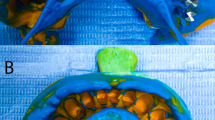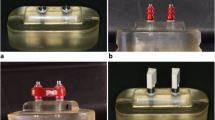Abstract
Objectives
The objective of this study was to evaluate the accuracy of different impression techniques on multiple implants.
Material and methods
A master cast simulating a jaw with four implants was used.
Eight impression techniques were tested: open tray-polyether#1, open tray plus splint of impression copings with acrylic resin-polyether#1, closed tray-polyether#1, open tray-polyether#2, open tray-splint-polyether#2, closed tray-polyether#2, open tray-impression plaster, and digital impression (DI).
Five impressions of the master cast were taken with each traditional impression (TI) technique, pouring 35 sample casts. Three different clinicians took 5 DI each (n = 15).
A three-dimensional coordinate measurement machine (CMM) was used to measure implant angulation and inter-implant distances on TI casts. TI data and DI Standard Tessellation Language datasets were compared with the master cast.
The best and the worst impressions made with TI and DI were selected to fabricate four milled titanium frameworks. Passive fit was evaluated through Sheffield test, screwing each framework on the master cast. Gaps between framework-implant analogs were measured through a stereomicroscope (×40 magnification).
Results
Statistically significant differences in accuracy were found comparing the different impression techniques by CMM (p < 0.01). DI performed the best, while TI techniques revealed a greater variability in the results.
Sheffield test revealed a mean gap of 0.022 ± 0.023 mm (the best TI), 0.063 ± 0.059 mm (the worst TI), 0.015 ± 0.011 mm (the best DI), and 0.019 ± 0.015 mm (the worst DI).
Conclusions
Within the limits of this in vitro study, the digital impression showed better accuracy compared to conventional impressioning.
Clinical relevance
The digital impression might offer a viable alternative to traditional impressions for fabrication of full-arch implant-supported prostheses with satisfactory passive fit.








Similar content being viewed by others
References
Buzayan MM, Yunus NB (2014) Passive fit in screw retained multi-unit implant prosthesis understanding and achieving: a review of the literature. J Indian Prosthodont Soc 14:16–23
Lee H, So JS, Hochstedler JL, Ercoli C (2008) The accuracy of implant impressions: a systematic review. J Prosthet Dent 100:285–291
Shadid R, Sadaqa N (2012) A comparison between screw- and cement-retained implant prostheses. A literature review. J Oral Implantol 38:298–307
Pera P, Menini M, Bevilacqua M, Pesce P, Pera F, Signori A, Tealdo T (2014) Factors affecting the outcome in the immediate loading rehabilitation of the maxilla: a 6-year prospective study. Int J Periodontics Restorative Dent 34:657–665
Menini M, Dellepiane E, Pera P, Bevilacqua M, Pesce P, Pera F, Tealdo T (2016) A luting technique for passive fit of implant-supported fixed dentures. J Prosthodont 25:77–82
Stimmelmayr M, Güth JF, Erdelt K, Edelhoff D, Beuer F (2012) Digital evaluation of the reproducibility of implant scanbodyfit—an in vitro study. Clin Oral Investig 16:851–856
Pera F, Pesce P, Bevilacqua M, Setti P, Menini M (2016) Analysis of different impression techniques and materials on multiple implants through 3-dimensional laser scanner. Implant Dent 25:232–237
Heckmann SM, Karl M, Wichmann MG, Winter W, Graef F, Taylor TD (2004) Cement fixation and screw retention: parameters of passive fit. An in vitro study of three-unit implant-supported fixed partial dentures. Clin Oral Implants Res 15:466–473
Baig MR (2014) Accuracy of impressions of multiple implants in the edentulous arch: a systematic review. Int J Oral Maxillofac Implants 29:869–880
Humphries RM, Yaman P, Bloem TJ (1990) The accuracy of implant master casts constructed from transfer impressions. Int J Oral Maxillofac Implants 5:331–336
De La Cruz JE, Funkenbusch PD, Ercoli C, Moss ME, Graser GN, Tallents RH (2002) Verification jig for implant-supported prostheses: a comparison of standard impressions with verification jigs made of different materials. J Prosthet Dent 88:329–336
Naconecy MM, Teixeira ER, Shinkai RS, Frasca LC, Cervieri A (2004) Evaluation of the accuracy of 3 transfer techniques for implant-supported prostheses with multiple abutments. Int J Oral Maxillofac Implants 19:192–198
Vigolo P, Majzoub Z, Cordioli G (2003) Evaluation of the accuracy of three techniques used for multiple implant abutment impressions. J Prosthet Dent 89:186–192
Burawi G, Houston F, Byrne D, Claffey N (1997) A comparison of the dimensional accuracy of the splinted and unsplinted impression techniques for the Bone-Lockimplant system. J Prosthet Dent 77:68–75
Chang WG, Vahidi F, Bae KH, Lim S (2012) Accuracy of three implant impression techniques with different impression materials and stones. Int J Prosthodont 25:44–47
Conrad HJ, Pesun IJ, DeLong R, Hodges JS (2007) Accuracy of two impression techniques with angulated implants. J Prosthet Dent 97:349–356
Kim S, Nicholls JI, Han CH, Lee KW (2006) Displacement of implant components from impressions to definitive casts. Int J Oral Maxillofac Implants 21:747–755
Choi JH, Lim YJ, Yim SH, Kim CW (2007) Evaluation of the accuracy of implant-level impression techniques for internal-connection implant prostheses in parallel and divergent models. Int J Oral Maxillofac Implants 22:761–768
Lin WS, Harris BT, Zandinejad A, Morton D (2014) Use of digital data acquisition and CAD/CAM technology for the fabrication of a fixed complete dental prosthesis on dental implants. J Prosthet Dent 111:1–5
Giménez B, Özcan M, Martínez-Rus F, Pradíes G (2015) Accuracy of a digital impression system based on active wavefront sampling technology for implants considering operator experience, implant angulation, and depth. Clin Implant Dent Relat Res 17:54–64
Seelbach P, Brueckel C, Wöstmann B (2012) Accuracy of digital and conventional impression techniques and workflow. Clin Oral Investig 17:1759–1764
Patzelt SB, Bishti S, Stampf S, Att W (2014) Accuracy of full-arch scans using intraoral scanners. Clin Oral Investig 18:1687–1694
Ting-Shu S, Jian S (2015) Intraoral digital impression technique: a review. J Prosthodont 24:313–321
Keul C, Stawarczyk B, Erdelt KJ, Beuer F, Edelhoff D, Güth JF (2014) Fit of 4-unit FDPs made of zirconia and CoCr-alloy after chairside and labside digitalization-a laboratory study. Dent Mater 30:400–407
Lee SJ, Gallucci GO (2013) Digital vs. conventional implant impressions: efficiency outcomes. Clin Oral Implants Res 24:111–115
Flügge TV, Schlager S, Nelson K, Nahles S, Metzger MC (2013) Precision of intraoral digital dental impressions with iTero and extraoral digitization with the iTero and a model scanner. Am J Orthod Dentofac Orthop 144:471–478
Wismeijer D, Mans R, van Genuchten M, Reijers HA (2014) Patients’ preferences when comparing analogue implant impressions using a polyether impression material versus digital impressions (Intraoral Scan) of dental implants. Clin Oral Implants Res 25:1113–1118
Syrek A, Reich G, Ranftl D, Klein C, Cerny B, Brodesser J (2010) Clinical evaluation of all-ceramic crowns fabricated from intraoral digital impressions based on the principle of active wavefront sampling. J Dent 38:553–559
Joda T, Katsoulis J, Brägger U (2015) Clinical fitting and adjustment time for implant-supported crowns comparing digital and conventional workflows. Clin Implant Dent Relat Res. https://doi.org/10.1111/cid.12377
Baig MR (2014) Multi-unit implant impression accuracy: a review of the literature. Quintessence Int 45:39–51
Kan JY, Rungcharassaeng K, Bohsali K, Goodacre CJ, Lang BR (1999) Clinical methods for evaluating implant framework fit. J Prosthet Dent 81:7–13
Hoods-Moonsammy VJ, Owen P, Howes DG (2014) A comparison of the accuracy of polyether, polyvinyl siloxane, and plaster impressions for long-span implant-supported prostheses. Int J Prosthodont 27:433–438
Assif D, Nissan J, Varsano I, Singer A (1999) Accuracy of implant impression splinted techniques: effect of splinting material. Int J Oral Maxillofac Implants 14:885–888
Burns J, Palmer R, Howe L, Wilson R (2003) Accuracy of open tray implant impressions: an in vitro comparison of stock versus custom trays. J Prosthet Dent 89:250–255
Shen C (2003) Impression materials. In: Anusavice KJ (ed) Phillips’ Science of Dental Materials, 11th edn. Saunders, Philadelphia, pp 205–254
Mojon P, Oberholzer JP, Meyer JM, Belser UC (1990) Polymerization shrinkage of index and pattern acrylic resins. J Prosthet Dent 64:684–688
Gibbs SB, Versluis A, Tantbirojn D, Ahuja S (2014) Comparison of polymerization shrinkage of pattern resins. J Prosthet Dent 112:293–298
Nejatidanesh F, Shakibamehr AH, Savabi O (2016) Comparison of marginal and internal adaptation of CAD/CAM and conventional cement retained implant-supported single crowns. Implant Dent 25:103–108
Ender A, Mehl A (2013) Accuracy of complete-arch dental impressions: a new method of measuring trueness and precision. J Prosthet Dent 109:121–128
Güth JF, Keul C, Stimmelmayr M, Beuer F, Edelhoff D (2013) Accuracy of digital models obtained by direct and indirect data capturing. Clin Oral Investig 17:1201–1208
Acknowledgements
The authors thank 3M ESPE for providing materials.
Furthermore, the authors wish to thank Prof. Fabrizio Barberis and Dr. Alberto Lagazzo (Department of Civil, Chemical and Environmental Engineering, University of Genova) for their assistance in data analysis.
Funding
The work was supported by the Department of Surgical and Diagnostic Sciences (DISC), Division of Prosthodontics, University of Genova, Genova, Italy.
Author information
Authors and Affiliations
Corresponding author
Ethics declarations
Conflict of interest
The authors declare that they have no conflict of interest.
Ethical approval
This article does not contain any studies with human participants or animals performed by any of the authors.
Informed consent
For this type of study, formal consent is not required.
Rights and permissions
About this article
Cite this article
Menini, M., Setti, P., Pera, F. et al. Accuracy of multi-unit implant impression: traditional techniques versus a digital procedure. Clin Oral Invest 22, 1253–1262 (2018). https://doi.org/10.1007/s00784-017-2217-9
Received:
Accepted:
Published:
Issue Date:
DOI: https://doi.org/10.1007/s00784-017-2217-9




